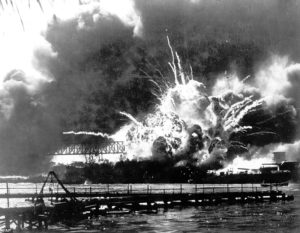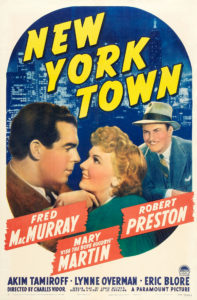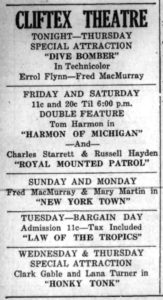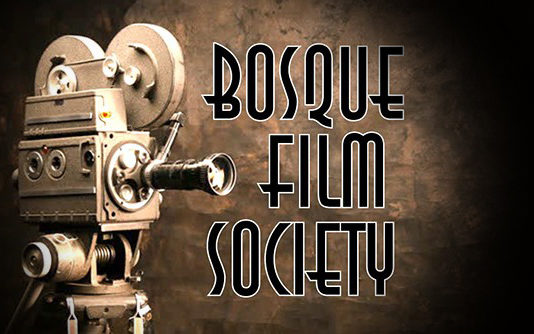Sunday, December 7, 1941: While the picture show went on with moviegoers unaware, it became a day that lives in infamy
by NATHAN DIEBENOW
Bosque Film Society Founding Secretary
CLIFTON – Eighty years ago, the unbelievable happened: the Imperial Japanese Navy Air Force attacked a United States naval base in broad daylight in Honolulu in the then-territory of Hawaii.
It occurred to the surprise of many ordinary people on the American mainland. Thousands of miles away across many time zones, most folks in Clifton, Texas, were probably heading to eat lunch after church at the time of the airstrikes on Pearl Harbor.

Those were the days before television, satellites, Internet, and smartphones, so news of the sneak attack would have spread by wire and radio, and the first visuals through black-and-white film footage showed in movie theaters days later.
Back then, our much beloved CLIFTEX Theatre would have been 25 years old, yet already a veteran of screening news reels of the previous World War – aka “The war to end all wars.”
While I don’t know whether or not Cliftonites and their neighbors went to their local picture show that evening in light of the attack on U.S. military forces, we do know the name of the full-length film scheduled to play thanks to the back issues of The Clifton Record.
The film to be presented by The CLIFTEX’s then-owners – D.C. and Beulah Caraway – was NEW YORK TOWN, starring Fred MacMurray, Marty Martin, and Robert Preston.
This 1941 romantic-comedy is about a down-on-his-luck photographer (MacMurray) who assists an ambitious, small town girl (Martin) in navigating New York City only to fall in love with her after she meets the son of a blue-blooded elite (Preston).

In typical rom-com fashion, the would-be couple can’t seem to decide whether they’re made for each other between their fights and flights. According to AllMovie.com, one thing that makes the film stand out from the rest is its “single take” at the beginning that establishes the folks who live in apartments.
This Paramount black-and-white release was directed by Charles Vidor, filmed by Charles Schoenbaum, and written by Jo Swerling, Lewis Meltzer, and Preston Sturges.
Vidor may not be as well-known to American audiences as other European directors are, but as a filmmaker, he directed Rita Hayworth and Gene Kelly in COVER GIRL (1944), Glenn Ford and Hayworth again in GILDA (1946), James Cagney and Doris Day in LOVE ME OR LEAVE ME (1955), Grave Kelly and Alec Guinness in THE SWAN (1956), and Frank Sinatra and Mitzi Gaynor in THE JOKER IS WILD (1957).
Similarly, Schoenbaum might not be a household name today, yet he filmed over 100 motion pictures and was nominated for an Academy Award in cinematography (color) for LITTLE WOMEN in 1949. (He lost the Oscar trophy to Winton C. Hoch who filmed SHE WORE A YELLOW RIBBON.) Schoenbaum also filmed a number of LASSIE films in the 1940s.
However, cinefiles may remember MacMurray from such classics as TRUE CONFESSION (1937), REMEMBER THE NIGHT (1940), and DOUBLE INDEMNITY (1944) as well as a number of Disney films. Television enthusiasts will especially remember him as Steve Douglas from the TV series “My Three Sons.”
Likewise, Preston’s film career spanned 50 years and spawned classics like BEAU GESTE (1939), THE MUSIC MAN (1962), and VICTOR/VICTORIA (1982). Generation X’ers like me remember him as the alien recruiter Centauri in THE LAST STARFIGHTER (1984).
Of the three stars, Martin is the only Texan. Born in Weatherford to a lawyer and a violin instructor, she became a Broadway star during the Great Depression, according to the Internet Movie Database. Over her career on Broadway, she won four Tony Awards, three of which were for Best Actress (Musical) awards.

Though Martin won a Peabody Award for her role in the television film VALENTINE (1979), she is perhaps better known as Peter Pan in the 1960 TV-movie adaptation of J. M. Barrie’s character. Due to health issues, she passed on a role in which she would have played the mother of J.R. Ewing – who was played by her son, Larry Hagman – in the hit television series “Dallas” (1978).
The team of screenwriters for NEW YORK TOWN were also remarkable. Among Swerling’s credits include THE PRIDE OF THE YANKEES (1942), which earned him an Academy Award nomination; Meltzer, THE MAN WITH THE GOLDEN ARM (1955); and Sturges, THE GREAT MCGINTY (1940), which won him the Oscar for Best Original Screenplay.
Unfortunately, it seems like NEW YORK TOWN is not currently available for film screenings. Since its original release on October 31, 1941, it’s never been for sale for home video or video disc either as far as I know.
That said, another of MacMurray’s films DIVE BOMBER played The CLIFTEX days prior to the Pearl Harbor attack. Hollywood legend Errol Flynn starred in the lead role of this Technicolor picture about a flight surgeon driven to study the effects of high altitudes on fighter pilots.
The U.S. Department of the Navy threw its full support behind DIVE BOMBER after reading the script, and requested it be released quickly, according to published accounts. Even before the infamous attack in Hawaii, this fictional film was a hit at the box office in the fall of 1941, and is still available for viewing on DVD and online streaming services today.
Thanks goes out to W. Leon Smith, the late editor/publisher of The Clifton Record and former owner of The CLIFTEX for this piece. Without him donating copies of the Clifton newspaper to the University of North Texas Libraries for digital transfer, we wouldn’t have been able to easily peer into Bosque County’s past on The Portal to Texas History online.
Special thanks also goes to the Nellie Pederson Civic Library – the public library in Clifton – for serving as the institutional conduit to the UNT Libraries.
Photos courtesy of DOCTOR MARCO GALLERIES & PARAMOUNT PICTURES
